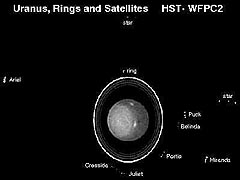
| Bad Astronomy |
|
|
|
BA Blog
|
|
Q & BA
|
|
Bulletin Board
|
| Media |
|
|
|
Bitesize Astronomy
|
|
Bad Astro Store
|
|
Mad Science
|
|
Fun Stuff
|
| Site Info |
|
|
|
Links
|
| RELATED SITES |
| - Universe Today |
| - APOD |
| - The Nine Planets |
| - Mystery Investigators |
| - Slacker Astronomy |
| - Skepticality |
Buy My Stuff

Keep Bad Astronomy close to your heart, and help make me
filthy rich. Hey, it's either this or one of those really
irritating PayPal donation buttons here.
The Last Visible Planet
Week of September 22, 1997Quick: how many planets can you see with the unaided eye? I'll warn you now, this is a trick question.

Give up? Let's count: Mercury, Venus, Earth (ha, I told you this was a trick question [Note added July 9, 1999: D'oh! That's wrong: see note at end of page]), Mars, Jupiter, and Saturn. Six, right?
But wait! This question is trickier than you thought. Ancient astronomers only knew about these planets (they also counted the Moon to be a planet, making the total a lucky seven). But there was another they appeared to have missed.
The planet Uranus was the first to be discovered using a telescope. William Herschel found it on March 13, 1781, and was the first to recognize it as a planet. Oddly, it had actually been seen many times before, but astronomers assumed it was a star! The famous astronomer Flamsteed, who made an early catalog of stars, even gave it a stellar designation: 34 Tauri.
All this may not surprise you, except for one fact: Uranus is bright enough to be seen by the naked eye! Well, barely. At magnitude 6 or so, it is just at the limit of normal vision (although at extraordinarily dark sites, like at the Nebraska Star Party, many people claim-- and I have no reason to disbelieve them-- that they can see stars down to about magnitude 7.5 or so). Through the past few snacks I have commented on the abilities of pre-telescope astronomers, and here I wonder how they could have dropped the ball. One explanation, of course, is that they made the same mistake Flamsteed did: they assumed it was a star and didn't think twice about it.
But I wonder... a new planet would have upped the total to eight, which has no fundamental mystic significance. I am not saying they suppressed knowledge of Uranus, but perhaps they simply were not inclined to go looking for it. If you think you've seen everything there is, why look for more? To add fuel to this, at least one asteroid-- Vesta-- is also bright enough to be seen by the unaided eye. How could they have missed both? Perhaps their eyes saw these two objects, but their prejudices blinded them.
Take a look around you. Observe your environment that you've seen so many times before.
What are you missing?
Want to know more about Uranus? The Nine Planets is loaded with info. You can skip right to the Uranus pages too.
[ Note (July 9, 1999): The seven planets of the ancients were Mercury, Venus, Mars, Jupiter, Saturn, the Sun and the Moon. The Earth didn't count; it wasn't a heavenly body! They did count the Sun and Moon though.]
|
|
| THE PANTRY: ARCHIVE OF BITESIZE SNACKS |
|
|
| Subscribe to the Bad Astronomy Newsletter! |
| Talk about Bad Astronomy on the BA Bulletin Board! |